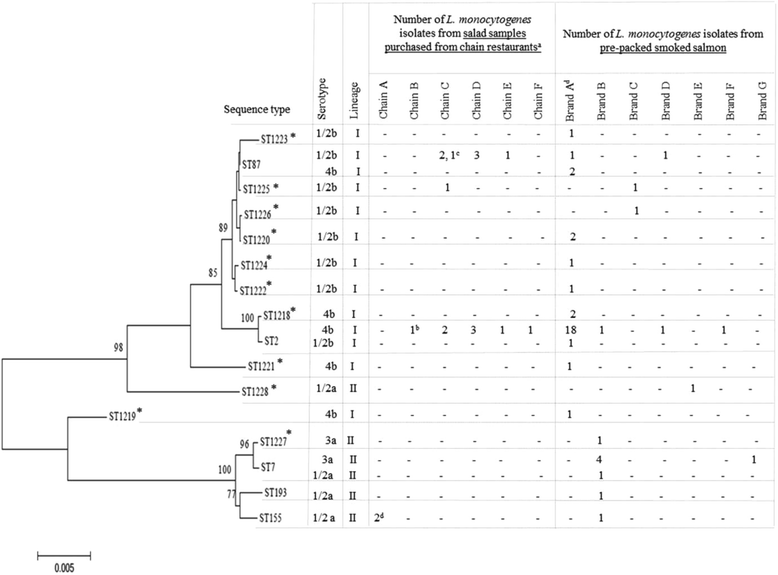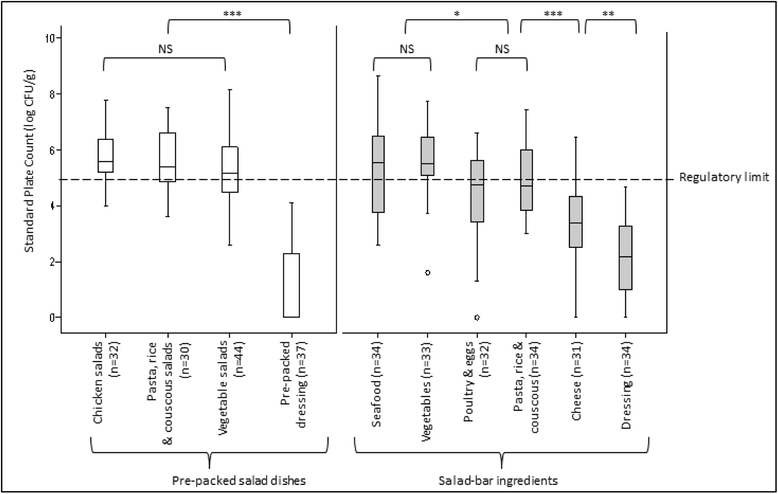Microbial survey of ready-to-eat salad ingredients sold at retail reveals the occurrence and the persistence of Listeria monocytogenes Sequence Types 2 and 87 in pre-packed smoked salmon
- PMID: 28245788
- PMCID: PMC5331722
- DOI: 10.1186/s12866-017-0956-z
Microbial survey of ready-to-eat salad ingredients sold at retail reveals the occurrence and the persistence of Listeria monocytogenes Sequence Types 2 and 87 in pre-packed smoked salmon
Abstract
Background: As the preparation of salads involves extensive handling and the use of uncooked ingredients, they are particularly vulnerable to microbial contamination. This study aimed to determine the microbial safety and quality of pre-packed salads and salad bar ingredients sold in Singapore, so as to identify public health risks that could arise from consuming salads and to determine areas for improvement in the management of food safety.
Results: The most frequently encountered organism in pre-packed salad samples was B. cereus, particularly in pasta salads (33.3%, 10/30). The most commonly detected organism in salad bar ingredients was L. monocytogenes, in particular seafood ingredients (44.1%, 15/34), largely due to contaminated smoked salmon. Further investigation showed that 21.6% (37/171) of the pre-packed smoked salmon sold in supermarkets contained L. monocytogenes. Significantly higher prevalence of L. monocytogenes and higher Standard Plate Count were detected in smoked salmon at salad bars compared to pre-packed smoked salmon in supermarkets, which suggested multiplication of the organism as the products move down the supply chain. Further molecular analysis revealed that L. monocytogenes Sequence Type (ST) 2 and ST87 were present in a particular brand of pre-packed salmon products over a 4-year period, implying a potential persistent contamination problem at the manufacturing level.
Conclusions: Our findings highlighted a need to improve manufacturing and retail hygiene processes as well as to educate vulnerable populations to avoid consuming food prone to L. monocytogenes contamination.
Keywords: Food safety; Listeria monocytogenes; Microbial safety and quality; Multi Locus Sequence Typing (MLST); Salads; Smoked salmon.
Figures


Similar articles
-
Prevalence and level of Listeria monocytogenes and other Listeria species in retail pre-packaged mixed vegetable salads in the UK.Food Microbiol. 2007 Oct-Dec;24(7-8):711-7. doi: 10.1016/j.fm.2007.03.009. Epub 2007 Apr 3. Food Microbiol. 2007. PMID: 17613368
-
Examination of Listeria monocytogenes in Seafood Processing Facilities and Smoked Salmon in the Republic of Ireland.J Food Prot. 2015 Dec;78(12):2184-90. doi: 10.4315/0362-028X.JFP-15-233. J Food Prot. 2015. PMID: 26613913
-
Microbiological safety of sandwiches from hospitals and other health care establishments in the United Kingdom with a focus on Listeria monocytogenes and other Listeria species.J Food Prot. 2008 Feb;71(2):309-18. doi: 10.4315/0362-028x-71.2.309. J Food Prot. 2008. PMID: 18326180
-
Prevalence and growth potential of Listeria monocytogenes in innovative, pre-packed, plant-based ready-to-eat food products on the Belgian market.Int J Food Microbiol. 2024 Jan 30;410:110506. doi: 10.1016/j.ijfoodmicro.2023.110506. Epub 2023 Nov 25. Int J Food Microbiol. 2024. PMID: 38043378 Review.
-
Listeria monocytogenes in the smoked salmon industry.Int J Food Microbiol. 2000 Dec 20;62(3):183-90. doi: 10.1016/s0168-1605(00)00334-2. Int J Food Microbiol. 2000. PMID: 11156261 Review.
Cited by
-
Isolation, Potential Virulence, and Population Diversity of Listeria monocytogenes From Meat and Meat Products in China.Front Microbiol. 2019 May 7;10:946. doi: 10.3389/fmicb.2019.00946. eCollection 2019. Front Microbiol. 2019. PMID: 31134008 Free PMC article.
-
Genetic diversity and profiles of genes associated with virulence and stress resistance among isolates from the 2010-2013 interagency Listeria monocytogenes market basket survey.PLoS One. 2020 Apr 30;15(4):e0231393. doi: 10.1371/journal.pone.0231393. eCollection 2020. PLoS One. 2020. PMID: 32352974 Free PMC article.
-
Assessing the Public Health Implications of Virulent and Antibiotic-Resistant Bacteria in Côte d'Ivoire's Ready-to-Eat Salads.Int J Microbiol. 2024 Aug 6;2024:3264533. doi: 10.1155/2024/3264533. eCollection 2024. Int J Microbiol. 2024. PMID: 39139471 Free PMC article.
-
Listeria monocytogenes Assessment in a Ready-to-Eat Salad Shelf-Life Study Using Conventional Culture-Based Methods, Genetic Profiling, and Propidium Monoazide Quantitative PCR.Foods. 2021 Jan 24;10(2):235. doi: 10.3390/foods10020235. Foods. 2021. PMID: 33498826 Free PMC article.
-
Group B Streptococcus Infections Caused by Improper Sourcing and Handling of Fish for Raw Consumption, Singapore, 2015-2016.Emerg Infect Dis. 2017 Dec;23(12):2002-10. doi: 10.3201/eid2312.170596. Emerg Infect Dis. 2017. PMID: 29148967 Free PMC article.
References
-
- Centers for Disease Control and Prevention. Multistate outbreak of listeriosis linked to packaged salads produced at Springfield, Ohio Dole processing facility. [http://www.cdc.gov/listeria/outbreaks/bagged-salads-01-16/]. Accessed 6 Feb 2017.
MeSH terms
Substances
LinkOut - more resources
Full Text Sources
Other Literature Sources
Medical
Molecular Biology Databases
Research Materials

